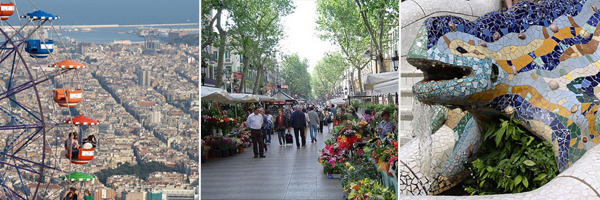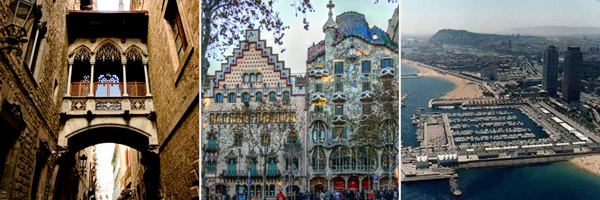
Barcelona
Almost 4.5 million people live in the Barcelona metropolitan area. The city enjoys a prime location, bathed by the sea and has excellent transport links with the rest of Europe. The Mediterranean and Europe are the defining characteristics of the capital of Catalonia.

Barcelona enjoys a Mediterranean climate, with mild winters and warm summers. It is a coastal city and has over four kilometers of urban beaches and large areas of nearby forest. Although it is a large city, it is easy to get around on public transport and on foot. You can reach any point in the city by metro, bus and taxi.
More information: www.barcelonaturisme.com

Climate
Barcelona's location on the shores of the Mediterranean means it enjoys a warm, welcoming climate, with pleasant temperatures all the year round. It has five kilometres of beaches with every amenity, which are used by Barcelona's inhabitants all the year round, and an Olympic marina which meets all the requisites in order to enjoy nautical sports throughout the year.
Rainfall, which is occasionally heavy, averages 1.000 mm. a year, making it possible to maintain the many green areas around the city.
Barcelona enjoys sunshine during all the seasons of the year. You can eat at open-air restaurants or enjoy a drink at any of its many pavement cafés, many of which are also along the Mediterranean shoreline.
Language
Most of Barcelona's inhabitants are bilingual and speak Catalan, their own language, and Spanish. These are the two official languages of Catalonia. Although street names and many road and transport signs are in Catalan, most of the city's signage is also in Spanish and English.
Many restaurants have menus in a number of languages. The Barcelonians are very hospitable and will help you to find your way around. Many of the city's inhabitants understand English and French.
Currency
Barcelona is in the European Union. Therefore, the currency is the EURO (€). You can change money at the city's banks and savings banks as well as the exchange booths located in the city centre and at tourist sights. There are also numerous exchange booths which open every day in the city centre and at the main tourist sights. The city's main railway and bus stations, Sants and Barcelona Nord bus station, also have exchange booths and cash dispensers (ATM machines).
Getting around the city
Public transport is the most practical way of getting around the city. We recommend you use public transport and alternative means of transport such as bicycles in order to get around the city. There is no better way to discover the city than by walking through its streets. If you come to the city by car your best bet is to leave your vehicle in a car park and enjoy your visit by bus, metro or taxi.
The venue is in the Avinguda Diagonal where you will find bus and underground connections.
METRO & FGC: Barcelona has eleven metro lines covering a total of 144,3 kilometers and passing through 180 stations.
- Barcelona underground (metro): www.tmb.net
- Ferrocarrils de la Generalitat de Catalunya: https://www.fgc.cat/en/
BUS: Barcelona has a fleet of 1000 buses which operate on over 80 routes and connect all the city's districts.
- Bus de Barcelona: www.tmb.net
More information: www.barcelonaturisme.com

What to visit
You will always find something to do in Barcelona. The city has over 50 museums, showcasing permanent collections of works by artists such as Picasso, Joan Miró and Antoni Tàpies, although most museums stage temporary exhibitions. Barcelona has museums devoted to art, science, sport, history, archaeology and many other fields. Be sure not to miss some of the most interesting, such as the Museu Picasso, the Museu d'Art Contemporani de Barcelona (MACBA), the Fundació Joan Miró and the Museu Nacional d'Art de Catalunya. They stand out not only for their incomparable works of art, but for their spectacular architectures. At Catalonia's National Gallery you can see one of the world's most important collections of Romanesque art. There are famous collections of contemporary art housed in museums such as the MACBA and CaixaForum. If you want to gain a better insight into the history of Barcelona, you can visit the Museu d'Història de la Ciutat located inside the Roman wall. You can also take a look at the many art galleries dotted around the city. The city is also a showcase for the best of the country's theatrical talent.
Barcelona is also renowned for its wide variety of musical events, which includes all the genres, and has three major venues: the Gran Teatre del Liceu, devoted to opera, the Palau de la Música, a modernist marvel, and L'Auditori, the concert hall designed by Rafael Moneo.
Barcelona is a box of surprises which will keep you entertained with countless cultural and recreational activities. Barcelona is an open-air museum. You can visit it by bus, bicycle or on foot, and enjoy its bustling streets. There are many ways to discover the city and a whole host of things to do, for those interested in culture, for those in search of entertainment or for those thinking about where to do some shopping.
- Day itineraries: www.barcelonaturisme.com/day-itineraries/
- Themed routes: www.barcelonaturisme.com/themed-routes/
History
The history of Barcelona extends over 4000 years, from the late Neolithic period, with the first remains found in the territory of the city until today. Its character takes the legacy of the Iberian peoples (laietans), Carthaginians, Romans, Jews, Visigoths, Muslims and Christians.
It has been suggested by several historians that character of the people from Barcelona has been built on armed conflicts which have almost always had a commun link: the defence of individual freedom and being against absolutism. The war "dels segadors" (1640), the site of 1714, the bombing of Barcelona in 1842 by General Espartero and in 1938 during the Spanish Civil War are examples of this. Voltaire spoke in 1751 of "the extreme love of the people from Barcelona for freedom".
To learn more about the history of the city we recommend reading:
- "Barcelona". Robert Hughes. English: Amazon
- "Barcelones". Manuel Vázquez Montalbán. English: Amazon
- Wikipedia "History of Barcelona": en.wikipedia.org/wiki/History_of_Barcelona
To learn more about the history of the city we recommend visiting:
- Museu d'Història de Barcelona: www.barcelona.cat/museuhistoria/en
- Museu d'Història de Catalunya: https://mhcat.cat/enmhc
- Archivo de la Corona de Aragón: www.culturaydeporte.gob.es/archivos-aca/en/portada.html
Useful phone numbers
|
Centralized emergency telephone: 112 Health Emergencies: 061 Fire: 080 Police (city): 092 Police (national): 088 |
TMB (Bus, Metro): 902.075.027 Ferrocarrils de la Generalitat: 012 Renfe: 912.320.320 Airport (information): 913.211.000 Taxis: 932.250.000 / 933.033.033 Taxis for disabled: 934.208.088 |
